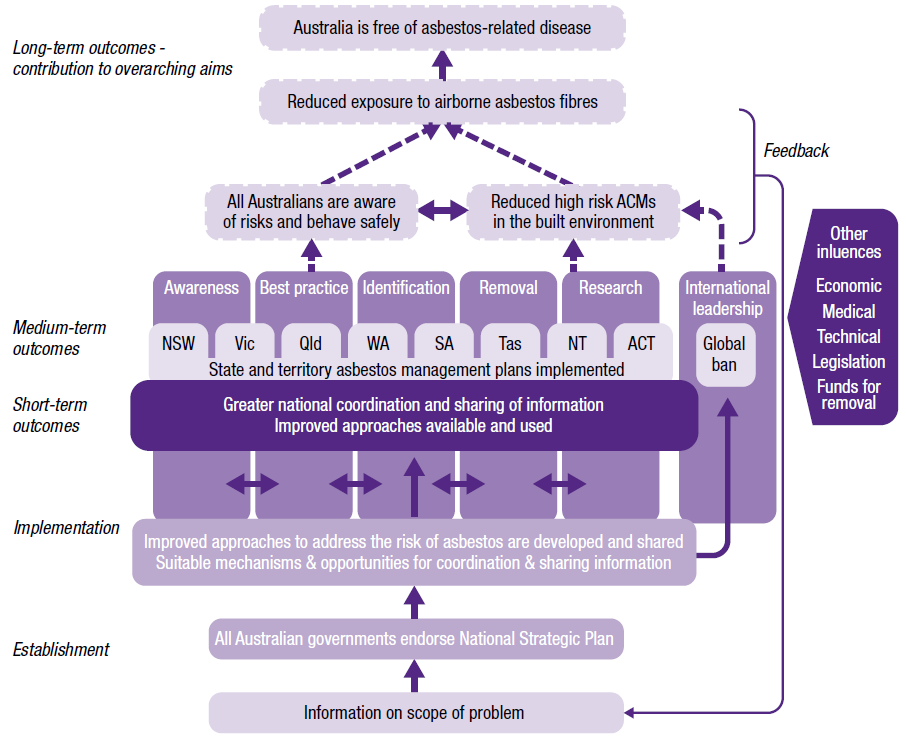Introductory statement
I, as the accountable authority of the Asbestos Safety and Eradication Agency, present the 2016–17 annual performance statement of the Asbestos Safety and Eradication Agency, as required under paragraph 39(1) (a) of the PGPA Act. In my opinion, these annual performance statements are based on properly maintained records, accurately reflect the performance of the entity, and comply with subsection 39(2) of the PGPA Act.
Purpose
Outcome one: to prevent exposure to asbestos fibres in order to eliminate asbestos-related disease in Australia.
Results against performance criteria
| Criterion one | Increase public awareness about asbestos safety | ||
|---|---|---|---|
| Source | National Strategic Plan for Asbestos Management and Awareness 2014–18 2016–17 Portfolio Budget Statement (page 58) ASEA Operational Plan 2016–17 (page 5) |
||
| 2016–17 targets | How was this measured? | Results against criterion | |
| Results against performance | Increase in utilization of agency information, resources and events | Demonstrated positive increase |
|
| Assessment: exceeded target (100% agreement) | |||
| Criterion two | Effectively coordinate national issues that relate to the plan and asbestos issues | ||
|---|---|---|---|
| Source | National Strategic Plan for Asbestos Management and Awareness 2014–18 2016–17 Portfolio Budget Statement (page 58) ASEA Operational Plan 2016–17 (page 5) |
||
| 2016–17 targets | How was this measured? | Results against criterion | |
| Results against performance |
|
More than 75% of council members agree |
|
| Assessment: exceeded target (100% agreement) | |||
| Criterion three | Identify targeted and practical initiatives to reduce the risks of asbestos-related disease in Australia | ||
|---|---|---|---|
| Source | National Strategic Plan for Asbestos Management and Awareness 2014–18 2016–17 Portfolio Budget Statement (page 58) ASEA Operational Plan 2016–17 (page 5) |
||
| 2016–17 targets | How was this measured? | Results against criterion | |
| Results against performance |
|
Project evaluations | Agency research highlights for 2016–17:
|
| Assessment: on track | |||
Analysis of performance against purpose
The evidence demonstrates that the agency continues to support effective national coordination and sharing of information about asbestos risks and the National Strategic Plan.
Overall, in 2016–17 the agency’s council and committee secretariat support has been consistent with 2015–16. The agency has increased focus on asbestos communications with the establishment of an additional working group, and has done extensive work to support the coordination of information and awareness of the risks of imported products containing asbestos via the Heads of Workplace Safety Authorities Working Group, a targeted information event in the ACT and a number of events held by Customs Brokers and Forwarders Council of Australia.
This information reflects the agency’s Portfolio Budget Statement and is consistent with the evaluation plan for the National Strategic Plan (referenced in the image on page 38). The alignment of the agency's program with the National Strategic Plan evaluation model shows how the short-term outcomes to increase national coordination and evidence will influence the medium and long-term outcomes of the National Strategic Plan, which are to reduce exposure to fibres in order to eliminate asbestos related disease.
Coordination of the National Strategic Plan:
The agency administers the National Strategic Plan by coordinating the activities, research and consultation that is undertaken in line with the plan and asbestos issues nationally across public health, environment and work health and safety.
This is achieved by working with the Asbestos Safety and Eradication Council under a tripartite framework; working with all levels of government, and employer and employee representatives, with the support of independent experts.
The agency has increased focus on asbestos communications with the establishment of an additional working group, and has done extensive work to support the coordination of information and awareness of the risks of imported products containing asbestos.
Council members have provided feedback on the work of the agency during 2016–17, and commented on their positive impression of the agency, general effectiveness, commitment to work and overall level of output produced by the agency. Additionally, members have highlighted the agency’s international engagement and leadership as a key point of impact that should receive continued focus in 2017–18.
Research themes:
The agency's role under the ASEA Act includes commissioning and promoting asbestos safety research (section 8(f)). During 2016–17, the agency established the following themes for asbestos research and evidence:
- residential risks
- environmental contamination
- asbestos legacy in the built environment
- awareness
- asbestos-related diseases and social impact
- data, evidence and trends.
Outlook for 2017-18
During 2017–18, the agency will complete a process evaluation of the National Strategic Plan to identify what areas have worked well, what can be improved and how this will contribute to more effective coordination regarding the plan and prevention of asbestos-related diseases in Australia. Since the formation of the nationally agreed plan, the agency has been coordinating quarterly national reporting and annual progress reports. This has highlighted extensive action being delivered in all jurisdictions that contribute to preventing asbestos-related diseases. In order to continue to build on this success, it is now time to review the agency’s coordination activities in order to identify areas to refine and improve. This will be used to inform the next phase of the plan, as we commence the preparatory work the National Strategic Plan for Asbestos Management and Awareness after 2018.
The agency program model demonstrating the contribution of short-term outcomes to the elimination of asbestos-related disease in Australia:

Source: National Strategic Plan evaluation framework (2015)


